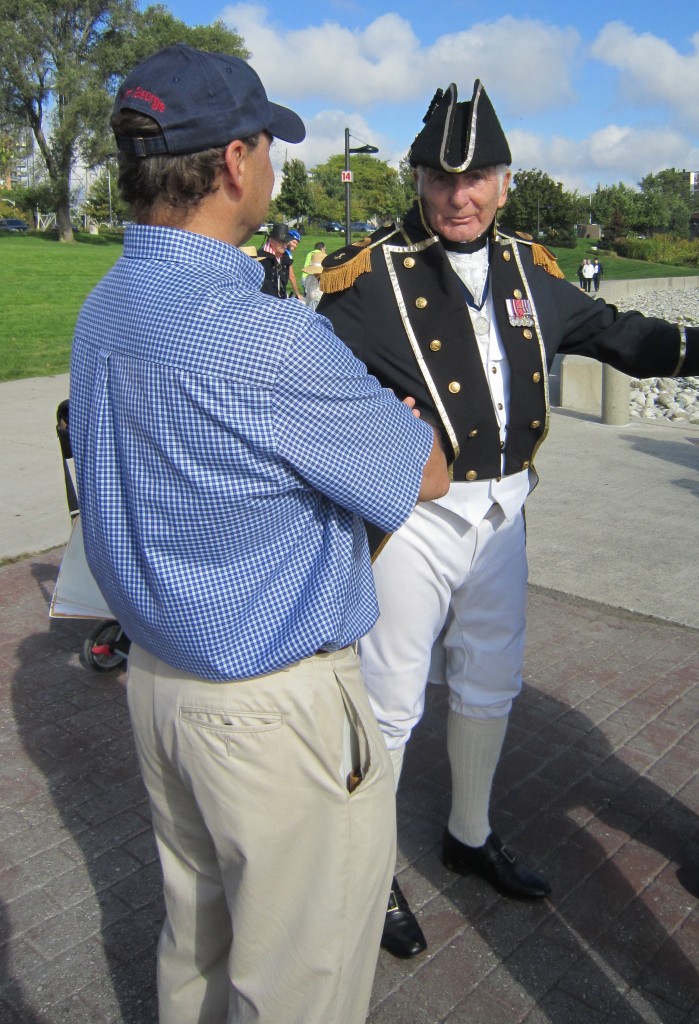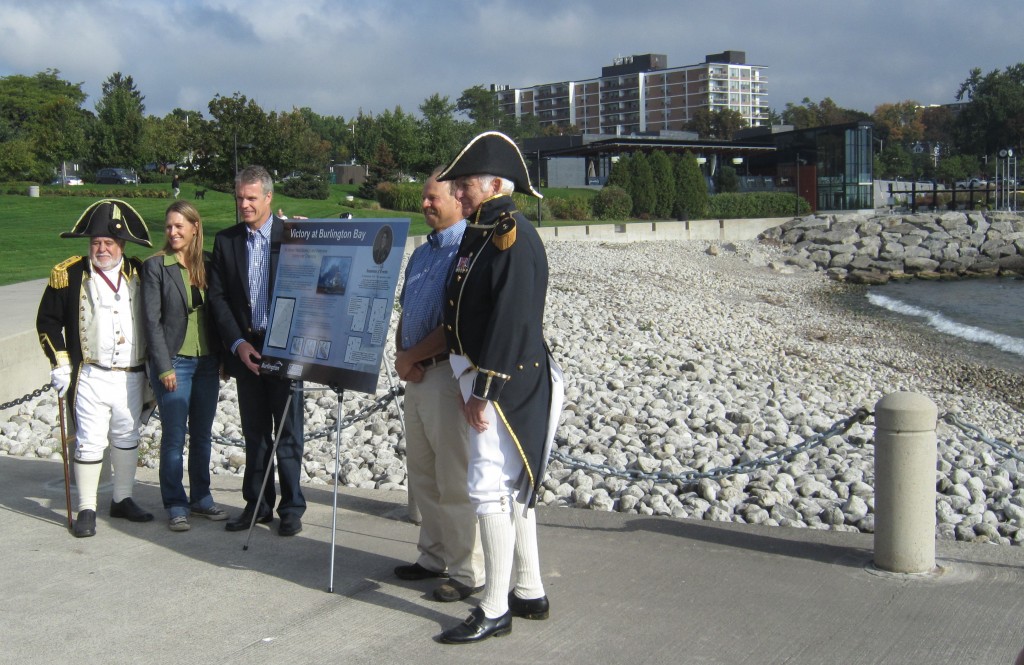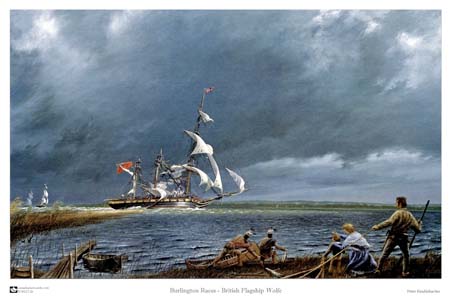By Pepper Parr
BURLINGTON, ON. It was a bright sunny day, one of those last reprieves summer sometimes gives while suggesting there is an Indian summer still ahead of us before the harvest season is over.
The bikes were out on the trails along the edge of the lake, Doors Open, the event that has historic and interesting places opening their doors for people to walk through and look around.

Rick Wilson, back to camera with War of 1812 enactor Robert Williamson talking over details of the desperate battles that played themselves out off the shores of Burlington 200 years ago.
A small group of people, some dressed up as re-enactors, were gathered on the promenade jutting out from the Naval Walk at the western end of Spencer Smith Park.

A classic photo-op that is drenched in Burlington history. The design of a plaque that will be installed on the Naval Walk commemorating a battle that was later seen as the turning point in the War of 1812. That stony stretch of beach in the background is where the Brant Inn was located. It was the jumpingest place in town in its day. People traveled from across Ontario and the United States by train t hear the great bands of the time.
The 50 square yard space was just drenched with history. Looking to the west is Burlington’s Bay, the entrance to one of the most industrial harbours in the country where tons of ore is brought in to fire the furnaces of the steel plants. A couple of yards from where an interpretive plaque that tells the story of a War of 1812 battle that took place out on that lake – out there in front of us is a stretch of stony beach that was once the location of the Brant Inn. It was a place that put Burlington on the map for many. In those days Burlington was a “jumping” town.
On this Saturday morning – exactly 200 years ago an event called the Burlington Races took place. The name come from a magazine article published 100 years ago that mis-represented what was happening with ships under full sail firing their cannons at each other was really all about.
It was a war that taught the Americans that Canada could perhaps be invaded but could not be conquered.
If the lakes were won said the better history books of the time, the war of 1812 was won. The British brought superior seamanship and better ships to the battle. The commanding officers of each fleet both held flag rank – Commodores both.
Burlington`s Mayor and the council member for the ward took part in the unveiling of a design that replicated the plaque that will eventually be put in place.

A great painting, full of dash and energy but the scene it depicts never took place. The artists didn’t know that when the work was done.
To commemorate the event and give it a level of legitimacy there were War of 1812 enactors on hand; Commodore Yeo of the British Navy and a British Royal Navy captain circa 1810 played by Gill Bibby.
Yeo was represented by Robert Williamson a Canadian Navy Commander who served as a Reserve officer, one time Commanding officer of HMCS Star in Hamilton. Williamson was a high school history and geography teacher.
Rick Wilson was the Burlington resident who used the research done by others to advocate for the removal of a plaque at the Burlington Heights in Hamilton which has been proven to be historically incorrect.
Robert Williamson was doing research on the Scourge and the Hamilton, simple merchant ships that were pressed into service for the American Navy just prior to the War of 1812. They went down in a gale and now lay at the bottom of Lake Ontario.
It was while doing this research on the Hamilton and the Scourge that Williamson accidently came across the existence of the log of HMS Wolfe which revealed facts that no one knew about. In is correspondence with Burlington Heritage Planner Jenna Paluto, Williamson set out the bigger picture:
“After the American naval victory on Lake Erie by Commodore Perry on September 10, 1813, a powerful United States fleet comprising ten ships under the command of Commodore Isaac Chauncey appeared off York (Toronto) on the morning of September 28, 1813. Their objective was to complete the American bid to gain control of the Great Lakes or at least create a diversion allowing the shipment of American troops from the Niagara frontier to the St. Lawrence River for an attack on Montreal.
“The smaller British fleet of six vessels, commanded by Commodore Sir James Yeo, was in the harbour but on the approach of the enemy, set sail to attack. After a sharp engagement the British flagship, HMS Wolfe, having suffered sail damage limiting her maneuverability, led the British squadron to a convenient anchorage in view of the present day City of Burlington. Commodore Yeo then had his squadron anchor close in shore with springs (heavy ropes) on the (anchor) cables allowing his ships to pivot and present powerful broadsides from a strong compact defensive unit that could not be enveloped from behind. The American fleet, having suffered battle damage as well, recognized the strong British position and withdrew to the protection of Fort Niagara, leaving the Royal Navy to quickly repair the sails and mast of their flagship, but still firmly in control of the lake.
“Control of Lake Ontario was essential to the British for the defense of Upper Canada (Ontario). By preserving a formidable presence on the lake, the British squadron was able to capture Fort Oswego in May 1814 and transferred General Drummond with 400 British reinforcements and supplies to the Niagara frontier in July to defeat the United States Army at Lundys Lane, the last invasion of Canada.”
It was that superb seamanship by a British naval officer off what Williamson believes was Bronte Creek that sent the Americans back to their home port.
Magazine writers who paid more attention to imaginative thinking than to historical fact
Williamson set out to correct the record which he did with a number of excellent papers.

Rick Wilson, the citizen who agitated and advocated for a correction to a grievous historical error.
Rick Wilson, a history buff, got hold of the information and began to agitate for a change that would correct the historical errors.
Wilson knocked on any door he could find – meeting with Burlington’s MP Mike Wallace who, while intrigued, had to back away because the plaques were a provincial responsibility. Wilson was able to get exactly nowhere with the office of Jane McKenna but he persevered and with the help of the Heritage Advisory Committee the city took on the task of creating a plaque.

















An 1815 Admiralty Chart shows Burlington Bay off of Spencer Smith, being the embayment formed by the merging of the Hamilton and Burlington shorelines on the Lake Ontario side, not the Harbour side.
This is consistent with the naming of Mexico Bay, which is at the East American shoreline with a similar merging on the Lake.
Pity they didn’t mention Capt Wm Mulcaster’s (RN)of the Royal George and its heroic action in saving the Wolfe from certain destruction when Chauncy’s General Pike bore down on her with Wolfe’s foretopmast shotaway dragging in the water.
Mulcaster and crew, out gunned, hoveto between the Pike and Wolfe and endured a murderous bombardment from the Pike. Returning fire with their 32lb carronades. That action brokeup Pike’s attack on Yeo’s flagship Wolfe and gave Wolfe’s crew sufficient time to cut away their damaged rig.
Mulcaster’s career is worth a read.
“In 1813, Mulcaster was sent to Upper Canada with Commodore Yeo’s 450-man naval detachment. At Kingston, Mulcaster received command of the 21-gun sloop Royal George. He took part in all of the naval actions on Lake Ontario during that year. His most memorable engagement occurred on 28 September 1813 during the Burlington Races, an encounter between the British and American squadrons 20 kilometres south of York. At a pivotal moment in the battle, Mulcaster maneuvered his sloop between Yeo’s badly damaged flagship Wolfe and the American flagship General Pike, saving Yeo’s command from being boarded by the enemy. An intense cannonade followed, and Yeo was able to restore order on Wolfe. The British squadron broke away and sought refuge in Burlington Bay, still pursued by the Americans. Hostile gales and the threat of British guns forced the Americans to call off the chase, and Mulcaster was promoted to a post captain in recognition of his service.” https://www.eighteentwelve.ca/?q=eng/Topic/89
Had it not been for Mulcaster’s heroic action, the War might have ended that very afternoon with the loss of the Royal Navy on both Great Lakes Erie and Ontario.